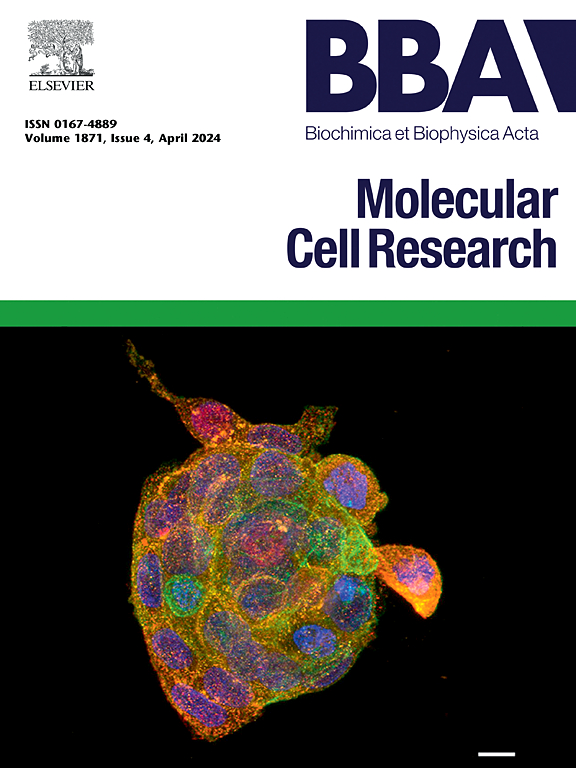Salinomycin inhibits SREBP1 to sensitize ferroptosis and ameliorate sorafenib resistance in clear cell renal cell carcinoma
IF 3.7
2区 生物学
Q1 BIOCHEMISTRY & MOLECULAR BIOLOGY
Biochimica et biophysica acta. Molecular cell research
Pub Date : 2025-05-11
DOI:10.1016/j.bbamcr.2025.119989
引用次数: 0
Abstract
Backgrounds
Resistance to sorafenib, a frontline therapy for advanced ccRCC, is associated with decreased sensitivity to ferroptosis. Our research focuses on elucidating the mechanisms underlying ccRCC's resistance to sorafenib-induced ferroptosis and identifying potential new agents that could overcome this resistance.
Methods
The silencing of SREBP1 was employed to evaluate the role of this key transcription factor in lipid synthesis and its contribution to ferroptosis resistance in sorafenib-treated ccRCC cells. The ATF4-mediated induction of SREBP1 following salinomycin treatment was assessed by western blot, RT-PCR, immunohistochemistry, chromatin immunoprecipitation, and dual-luciferase reporter assays. In cultured ccRCC cells, the combined effects of salinomycin and sorafenib on ferroptosis induction were evaluated by assessing cell viability, glutathione levels, malondialdehyde levels, BODIPY fluorescence, and intracellular Fe2+ concentration. In an orthotopic ccRCC mouse model, the synergistic effects of salinomycin and sorafenib on both ferroptosis and tumor progression were examined.
Results
Overexpression of SREBP1 was observed in ccRCC tumor tissue, and induced by sorafenib treatment. Silencing SREBP1 reduced the resistance of ccRCC cells to ferroptosis induced by sorafenib. Salinomycin decreased ATF4 level, which in turn inhibited SREBP1 transcription. Treatment with salinomycin enhanced the sensitivity of ccRCC cells to sorafenib-induced ferroptosis. In the orthotopic xenograft mouse model of ccRCC, the combination of salinomycin and sorafenib showed a synergistic effect in inducing ferroptosis inhibiting tumor growth.
Conclusions
Salinomycin treatment mitigates resistance to sorafenib-induced ferroptosis by inhibiting SREBP1. The combination of salinomycin and sorafenib synergistically enhances ferroptosis and suppresses ccRCC growth.
盐霉素抑制SREBP1对透明细胞肾细胞癌中铁中毒致敏并改善索拉非尼耐药。
索拉非尼是晚期ccRCC的一线治疗药物,对索拉非尼的耐药性与对铁下垂的敏感性降低有关。我们的研究重点是阐明ccRCC对索拉非尼诱导的铁下垂的耐药机制,并确定可能克服这种耐药的潜在新药。方法:采用沉默SREBP1的方法,评估该关键转录因子在索拉非尼处理的ccRCC细胞脂质合成中的作用及其对铁下沉抗性的贡献。通过western blot、RT-PCR、免疫组织化学、染色质免疫沉淀和双荧光素酶报告基因检测来评估盐霉素治疗后atf4介导的SREBP1诱导。在培养的ccRCC细胞中,通过评估细胞活力、谷胱甘肽水平、丙二醛水平、BODIPY荧光和细胞内Fe2+浓度来评估Salinomycin和sorafenib联合对铁死亡诱导的影响。在原位ccRCC小鼠模型中,研究了盐碱霉素和索拉非尼对铁下垂和肿瘤进展的协同作用。结果:SREBP1在ccRCC肿瘤组织中过表达,并经索拉非尼治疗诱导。沉默SREBP1可降低ccRCC细胞对索拉非尼诱导的铁凋亡的抗性。盐碱霉素降低ATF4水平,从而抑制SREBP1转录。盐霉素治疗可增强ccRCC细胞对索拉非尼诱导的铁下垂的敏感性。在ccRCC原位异种移植小鼠模型中,盐碱霉素与索拉非尼联用在诱导铁下垂抑制肿瘤生长方面表现出协同作用。结论:盐碱霉素治疗可通过抑制SREBP1减轻索拉非尼诱导的铁下垂的耐药性。盐碱霉素和索拉非尼联用可协同促进铁下垂,抑制ccRCC生长。
本文章由计算机程序翻译,如有差异,请以英文原文为准。
求助全文
约1分钟内获得全文
求助全文
来源期刊
CiteScore
10.00
自引率
2.00%
发文量
151
审稿时长
44 days
期刊介绍:
BBA Molecular Cell Research focuses on understanding the mechanisms of cellular processes at the molecular level. These include aspects of cellular signaling, signal transduction, cell cycle, apoptosis, intracellular trafficking, secretory and endocytic pathways, biogenesis of cell organelles, cytoskeletal structures, cellular interactions, cell/tissue differentiation and cellular enzymology. Also included are studies at the interface between Cell Biology and Biophysics which apply for example novel imaging methods for characterizing cellular processes.

 求助内容:
求助内容: 应助结果提醒方式:
应助结果提醒方式:


